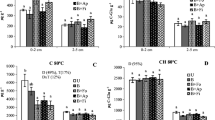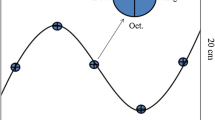Abstract
The influence of a fire retardant (Firesorb, an acrylic–acrylamide copolymer) on the microbial community structure determined by phospholipid fatty acid (PLFA) analysis was examined under laboratory conditions using two different textured soils under pine forest. Firesorb was added to unheated and heated soil samples (350°C for 10 min followed by reinoculation, to mimic a forest fire) at three levels of application (none, usual and three times the usual levels), and measurements were made after 12 weeks of incubation. The relative importance of the three factors considered on the PLFA profiles was as follows: soil heating ≫ soil texture ≈ Firesorb treatment. In the unheated soils, Firesorb had a larger effect than soil texture, while the opposite was found in the heated soils. Soil heating reduced the total PLFAs, while Firesorb tended to increase them in both the unheated and heated soils. Soil heating decreased the PLFAs indicative of gram-positive (G+) bacteria and tended to increase the fatty acids associated with gram-negative (G−) bacteria and, to a lesser extent, the PLFA 18:2ω6, considered to be predominantly of fungal origin. Firesorb treatment decreased the G−/G+ bacteria ratio in the heated soils but tended to increase it in the unheated soils, the effect being dose dependent.


Similar content being viewed by others
References
Bååth E, Frostegård A, Pennanen T, Fritze H (1995) Microbial community structure and pH response in relation to soil organic matter quality in wood ash fertilized, clear-cut or burned coniferous forest soils. Soil Biol Biochem 27:229–240
Bååth E, Nilsson LO, Göransson H, Wallander H (2004) Can the extent of degradation of soil fungal mycelium during soil incubation be used to estimate ectomycorrhizal biomass in soil? Soil Biol Biochem 36:2105–2109
Basanta MR, Díaz-Raviña M, González-Prieto SJ, Carballas T (2002) Biochemical properties of forest soils as affected by a fire retardant. Biol Fertil Soils 36:377–383
Basanta MR, Díaz-Raviña M, Cuiñas P, Carballas T (2004) Field data of microbial response to a fire retardant. Agrochimica 48:51–60
Bossio DA, Scow KM, Gunapala N, Graham KJ (1998) Determinants of soil microbial communities: effects of agricultural management, season, and soil type on phospholipid fatty acid profiles. Microb Ecol 36:1–12
Carballas T (2003) Los incendios forestales. In: Reflexiones sobre el medio ambiente en Galicia. Xunta de Galicia, Santiago de Compostela, Spain, pp 362–415/545–547
Carballas M, Acea MJ, Cabaneiro A, Trasar C, Villar MC, Díaz-Raviña M, Fernández I, Prieto A, Saá A, Vázquez FJ, Zëhner R, Carballas T (1994) Organic matter, nitrogen, phosphorus and microbial population evolution in forest humiferous acid soils after wildfires. In: Trabaud L, Prodon R (eds) Fire in Mediterranean ecosystems. Ecosystems research series. Report 5. EC, Brussels, Belgium, pp 379–385
Díaz-Raviña M, Prieto A, Acea MJ, Carballas T (1992) Fumigation–extraction method to estimate microbial biomass in heated soils. Soil Biol Biochem 24:259–264
Fritze H, Smolander A, Levula T, Kitunen V, Mälkönen E (1994) Wood-ash fertilization and fire treatments in a Scots pine forest stand: effects on the organic layer, microbial biomass and microbial activity. Biol Fertil Soils 17:57–63
Frostegård A, Bååth E (1996) The use of phospholipid fatty acid analysis to estimate bacterial and fungal biomass in soil. Biol Fertil Soils 22:59–65
Frostegård A, Bååth E, Tunlid A (1993) Shifts in the structure of soil microbial communities in limed forests as revealed by phospholipid fatty acid analysis. Soil Biol Biochem 25:723–730
Guckert JB, Hood MA, White DC (1986) Phospholipid ester-linked fatty acid profile changes during nutrient deprivation of Vibrio cholerae: increases in the trans/cis ratio and proportions of cyclopropyl fatty acids. Appl Environ Microbiol 52:794–801
Heipieper HJ, Meulenbeld G, van Oirschot Q, de Bont JAM (1996) Effect of environmental factors on the trans/cis ratio of unsaturated fatty acids in Pseudomonas putida S12. Appl Environ Microbiol 62:2773–2777
Kieft TL, Ringelberg DB, White DC (1994) Changes in ester-linked phospholipid fatty acid profiles of subsurface bacteria during starvation and desiccation in a porous media. Appl Environ Microbiol 60:3293–3299
Pettersson M, Bååth E (2003) The rate of change of a soil bacterial community after liming as a function of temperature. Microb Ecol 46:13–21
Pietikäinen J, Hiukka R, Fritze H (2000) Does short-term heating of forest humus change its properties as a substrate for microbes? Soil Biol Biochem 32:277–288
Prieto-Fernández A, Acea MJ, Carballas T (1998) Soil microbial and extractable C and N after wildfire. Biol Fertil Soils 27:132–142
Ranneklev S, Bååth E (2003) Use of phospholipid fatty acids to detect previous self-heating events in stored peat. Appl Environ Microbiol 69:3532–3539
Söderberg KH, Probanza A, Jumpponen A, Bååth E (2004) The microbial community in the rhizosphere determined by community-level physiological profiles (CLPP) and direct soil- and cfu-PLFA techniques. Appl Soil Ecol 25:135–145
Sutherland GRG, Haselbach J, Aust SD (1997) Biodegradation of crosslinked acrylic polymers by a white-root fungus. Environ Sci Pollut Res 4:16–20
Vance ED, Brookes PC, Jenkinson DS (1987) An extraction method for measuring soil microbial biomass C. Soil Biol Biochem 19:703–707
Vázquez FJ, Acea MJ, Carballas T (1993) Soil microbial populations after wildfire. FEMS Microbiol Ecol 13:93–104
Zelles L (1999) Fatty acid patterns of phospholipids and lipopolysaccharides in the characterisation of microbial communities in soil: a review. Biol Fertil Soils 29:111–129
Acknowledgements
The authors thank Stockhausen (Degüssa-Hüls Gruppe, Germany) for providing the acrylamide copolymer and N. Pérez Balsa for technical assistance. This study was supported by the Spanish Ministerio de Ciencia y Tecnología and FEDER founds from the EC (Project AGL2001-1242-CO4-01) and by the Swedish Research Council.
Author information
Authors and Affiliations
Corresponding author
Rights and permissions
About this article
Cite this article
Díaz-Raviña, M., Bååth, E., Martín, A. et al. Microbial community structure in forest soils treated with a fire retardant. Biol Fertil Soils 42, 465–471 (2006). https://doi.org/10.1007/s00374-005-0036-7
Received:
Revised:
Accepted:
Published:
Issue Date:
DOI: https://doi.org/10.1007/s00374-005-0036-7




